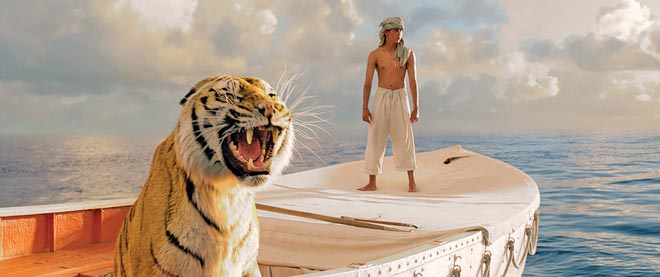A new life for Pi
Ang Lee recreates the story of a shipwreck, a boy and a tiger in three dimensions
Rhythm & Hues/Twentieth Century Fox Film Corporation
Share

In recent weeks, we’ve seen some Herculean efforts to bring “unfilmable” novels to the screen. It took three directors to wrangle Cloud Atlas, David Mitchell’s six-story opus, into a head-spinning Rubik’s cube of a movie spanning five centuries. Canadian director Deepa Mehta compressed six marriages, three generations and several wars—plus the birth of India, Pakistan and Bangladesh—into her sprawling adaptation of Salman Rushdie’s Midnight’s Children. And now Oscar-winning filmmaker Ang Lee (Brokeback Mountain) attempts a daredevil feat directing Life of Pi, an epic adventure based on the 2001 Booker Prize-winning bestseller by Saskatoon novelist Yann Martel.
It’s a movie on a more intimate scale, the story of a teenage boy who crosses two oceans in a lifeboat with a ferocious Bengal tiger. But Lee is messing with three classic elements that sensible movie-makers are advised to avoid: children, animals and water. As if that were not tricky enough, he’s done it in 3D.
The movie, opening Nov. 21, is remarkably close to Martel’s intricate novel, the story of a zoo owner’s son who escapes a sinking ship while emigrating to Canada from India with his family and a menagerie of beasts. But filming Life of Pi posed quite a different challenge than writing the novel. Martel just had to describe a tiger sharing a lifeboat with a boy, and expect the reader to suspend disbelief. Lee had to conjure the tiger onscreen with indisputable realism.
The director created a mongrel tiger from computer animation and shots of real tigers, combining them so seamlessly that it’s impossible to see where the animal leaves off and the digital image begins. “I brought four real tigers to the boat,” says Lee on the phone from New York, adding that 23 shots of them made it into the finished movie. “That’s very intimidating to the animation team,” he explains, “because they have to make it just as good as the real thing in 3D.” The animators, meanwhile, also worked with the production’s tiger trainers, who deserved a writing credit, adds Lee. “They showed how to stage a scene—what would the tiger do?”
Life of Pi marks Lee’s first venture into 3D, but he contemplated using the format for Pi almost a year before James Cameron’s Avatar (2009). “I used it as a language, the same way I’d use lenses,” he says. “When you have the illusion of depth, the staging is different. It’s not about how things fly through your eyes; 3D is good for water, which is both transparent and reflective.” The crew’s 3D camera gear came with a handbook written by Cameron, who knows a thing or two about shooting on and in water. “But we didn’t follow it,” says Lee. “I just figured it out myself.”
Martel was supportive, giving script advice in the early stages until Lee took over full custody. “At one point,” says the director, “I wrote to him and said it was time to start praying to the movie gods.” But the author, who’s seen the film three times, is pleased. “It’s very faithful, visually stunning, very appealing—and demanding,” he said last week. Demanding? “It’s a deceptively complicated movie,” says Martel, noting that the denouement’s twist goes by so fast, “if you blink, you might think it’s just the story of a castaway boy.”
The movie is less visceral than the book, omitting scenes of a turtle and a shark being butchered on the lifeboat, which Lee says would have forced “a hard R rating.” And Martel says his novel has been slightly sanitized. “For example, none of the animals has an anus,” he points out. “But that’s just Hollywood convention. They look really animal-like.”
The movie, meanwhile, rests on the slender shoulders of a 17-year-old from New Delhi named Suraj Sharma, who was chosen from a casting call of 3,000, although he’d never acted and couldn’t swim. But is he how Martel pictured Pi? “In the book, I never described Pi,” says the author. “It was unimportant to me what Pi looked like—everything is seen from his perspective. So do I like seeing Pi in the movie? It’s not the thing I like the most.” But Martel praises Sharma’s performance, which, in tandem with those mongrel stripes, has lent Pi a new life.